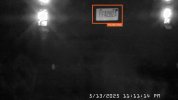Good IP Cameras That Don't Need IR Lights
- Thread starter mark4312
- Start date
You are using an out of date browser. It may not display this or other websites correctly.
You should upgrade or use an alternative browser.
You should upgrade or use an alternative browser.
Yeah as wittaj said most of the cameras are going to need a good amount of light. I mean I have a few cameras that are working on the lights of the outside of my home and works well enough even though I have the White Leds set to Auto they don't come on because the camera finds there is enough light.. Now one camera that I own don't have IR or White leds at all and while I can use in a well lit area I know that it wouldn't work to well in a very dark area.. I mean sure it will work but would not be that great of a video without light.. That is my Dahua N45EF63, Last FW was from 2023 and does offer a 1/1.8in sensor and f/1.0 and with some fancy Dahua software it will work great as long as there is enough light.. The sister camera that I also have with same guts besides comes with 4 white leds that is the Dahua N45EFN2.. So yeah if you are going to use a camera in an area with Motion Lights and want a camera that can work the 5442 line is hard to beat.. Have a few that are OEM 5442 with White leds color at night by design that work well in my normal lit front yard without the WL leds on. But picture looks much better with the LEDS on to be honest but I let the cameras control the lights in some dark areas I have WL lights for trigger in areas that I need them.
iwanttosee
Pulling my weight
If a camera can get a good background picture at night from just the ambient light, I guarantee any moving object will be blurry.
? Did you mean can't. I can tell you that my cameras with the Ambient light has no motion blur and my camera is running default camera settings just like it came out of the box.. Have cars that go by 20 to 30 miles if not more and have no blur?If a camera can get a good background picture at night from just the ambient light, I guarantee any moving object will be blurry.
looney2ns
IPCT Contributor
Show us.? Did you mean can't. I can tell you that my cameras with the Ambient light has no motion blur and my camera is running default camera settings just like it came out of the box.. Have cars that go by 20 to 30 miles if not more and have no blur?
bigredfish
Known around here
Do you have enough visible light or be willing to use the built-in white LED lights?
Despite the marketing hype, all cameras need light, either visible or infrared. They cannot defy physics.
^^^^
This is the correct answer
LOL I have shown it. How do you need me to prove that my camera is STOCK? Video is in my SMD thread of the camera without White Leds on and no ghosting.. No different today then it was then..
bigredfish
Known around here
Then you have a lot of ambient light
Or you’re about to become a billionaire selling these cameras that don’t need light
Could you post again here with settings and model #?
Or you’re about to become a billionaire selling these cameras that don’t need light
Could you post again here with settings and model #?
bigredfish
Known around here
? Did you mean can't. I can tell you that my cameras with the Ambient light has no motion blur and my camera is running default camera settings just like it came out of the box.. Have cars that go by 20 to 30 miles if not more and have no blur?
Some samples
4K-X- Auto- out of the box


1/120 exposure and other image adjustments


======================================
5442-ZE Auto out of the box


1/180 exposure



bigredfish
Known around here
I hope most here understand these 5 things:
1- looking at postage stamp images or video on a page means nothing. Click on thumbnails and Expand it to full screen /full resolution or just quit pretending and buy Reolink
2- making claims of image quality without providing real full resolution examples means nothing. My cat makes wild claims all the time until I physically show him that there is indeed food in the bowl
3- three things matter: clear facial ID, license plates, and clear more distant COLOR images/video overview shots showing vehicle model/color and clothing colors
4- it’s easy to make night color shots look good when the object is at a distance lacking high detail.
Notice how many manufacturer nighttime color videos show you pretty scenes of city lights at 500-1000 yds or more?
5- light trumps all other settings. With enough light, we could all buy $50 Chinese junk cameras and be done.
With enough light we can indeed get relatively good freeze frame images without messing with the settings. With enough light we can run small crappy 1/3 sensors or 1/2.8” sensors on 4 and 8MP cameras.
1- looking at postage stamp images or video on a page means nothing. Click on thumbnails and Expand it to full screen /full resolution or just quit pretending and buy Reolink
2- making claims of image quality without providing real full resolution examples means nothing. My cat makes wild claims all the time until I physically show him that there is indeed food in the bowl
3- three things matter: clear facial ID, license plates, and clear more distant COLOR images/video overview shots showing vehicle model/color and clothing colors
4- it’s easy to make night color shots look good when the object is at a distance lacking high detail.
Notice how many manufacturer nighttime color videos show you pretty scenes of city lights at 500-1000 yds or more?
5- light trumps all other settings. With enough light, we could all buy $50 Chinese junk cameras and be done.
With enough light we can indeed get relatively good freeze frame images without messing with the settings. With enough light we can run small crappy 1/3 sensors or 1/2.8” sensors on 4 and 8MP cameras.
biggen
Known around here
- May 6, 2018
- 2,820
- 3,227
Pretty much what @bigredfish said. If one is getting usuable video captures and no motion blurring with straight out-of-the box settings, then that manufacturer has to limiting shutter speed to a sane amount. I've yet to see ANY manufacturer do this with default settings. They know they will sell more cameras by advertising a night time landscape picture with a 1 second (or more) shutter speed. Motion blurring be damned. Just look how well lit this driveway is at 2am at night!
Totally fair points; I agree that resolution, lighting, and full-detail snapshots matter for evaluating performance. I wasn’t trying to make wild claims, just sharing my own setup where I’ve got decent ambient light and the cameras (like the N45EFN2) do a reasonable job for what I need, especially in lit areas where WL doesn't even need to activate. AS I Stated in my First Post here...
I get that some users expect forensic detail or license plate capture at range, and sure, that’s where better gear and tuning shines. But for residential setups with motion lights or good porch/street lighting, some of these Dahuas even without IR/WL hold up pretty well.
I’ll try to post a few full-res night shots from my setup if folks are interested not trying to mislead anyone, just sharing a working config that works for me in my Well lit area.. Now 1 thing that has changed since my SMD video is one of the Street lights is out at the distant right of the image. Not where my area of interest is and yes in that area now since that light is out does have some ghosting once a person enters that area. Again not my cameras Area of Interest and covered by another camera so it don't matter. But when I did the SMD thread that light was on and had better coverage..
My second post was trying to be clear if they mean can't or can because again with my lit area and the cameras Area Of Interest works well with the light outside.. Infact with LEDs on seems to have some motion blur again camera is setup for light Auto and they don't come on. Out of all 2024 might have come on 2 times that year.
I get that some users expect forensic detail or license plate capture at range, and sure, that’s where better gear and tuning shines. But for residential setups with motion lights or good porch/street lighting, some of these Dahuas even without IR/WL hold up pretty well.
I’ll try to post a few full-res night shots from my setup if folks are interested not trying to mislead anyone, just sharing a working config that works for me in my Well lit area.. Now 1 thing that has changed since my SMD video is one of the Street lights is out at the distant right of the image. Not where my area of interest is and yes in that area now since that light is out does have some ghosting once a person enters that area. Again not my cameras Area of Interest and covered by another camera so it don't matter. But when I did the SMD thread that light was on and had better coverage..
My second post was trying to be clear if they mean can't or can because again with my lit area and the cameras Area Of Interest works well with the light outside.. Infact with LEDs on seems to have some motion blur again camera is setup for light Auto and they don't come on. Out of all 2024 might have come on 2 times that year.
bigredfish
Known around here
yeah not ragging on you specifically, you just touched the nerve.
We see so many claims and yet so few actual full res snaps or pics.
I'll bet I post more actual full res pics and videos than just about anyone here. I do that becasue I try to be honest with the noobs (as well as some more seasoned members who rarely if ever post examples of their own camera's results) that come by here by the hundreds each month with just enough information to be dangerous.
When they start out with "I want great nighttime video without IR or white light LEDS because I read about "Starlight"... I know they watch way too much TV
For MOST of us without stadium lighting, nighttime video that is usable as evidence is Hard
If blurred crappy video is acceptable, why bother spending what we spend? Put up a Ring doorbell and a Eufy floodlight cam and call it a day
We see so many claims and yet so few actual full res snaps or pics.
I'll bet I post more actual full res pics and videos than just about anyone here. I do that becasue I try to be honest with the noobs (as well as some more seasoned members who rarely if ever post examples of their own camera's results) that come by here by the hundreds each month with just enough information to be dangerous.
When they start out with "I want great nighttime video without IR or white light LEDS because I read about "Starlight"... I know they watch way too much TV
For MOST of us without stadium lighting, nighttime video that is usable as evidence is Hard
If blurred crappy video is acceptable, why bother spending what we spend? Put up a Ring doorbell and a Eufy floodlight cam and call it a day
If my camera looked anything like the New Tech in this video I would just go back to my old Samsungs from 08 to 16 and only use them.. Because while they are saying at 608 ish that it is their best 4mp offered my much older camera from Dahua looks much better with or without light lol.. Sure not at static picture but any motion.. Plus the costly Owlview compared to a cheap Amazon camera is like someone COmparing a $30 JunkVision cam to a 500 OverHypedTech Ultra 9000 is like upgrading from a potato with night vision to a Gold Plated brick that promises Ai but thinks your dog is a Car Thief LOL..
iwanttosee
Pulling my weight
Awaiting for your pics. Here are my pics with IR.
View attachment 221082View attachment 221081View attachment 221083
I doubt these are on auto/default settings?
TheWaterbug
Known around here
Do you mean "without any IR illumination at all, including without the camera's built-in IR LEDs?" Or do you mean "with only the camera's built-in IR LEDs, but without adding external illuminators"?I've seen discussions here from a few years ago, but what kinds of cameras work well in outdoor night-time situations without IR lights? What does everyone like these days? I wouldn't mind seeing options in the sub-$200 range if that can be achieved.
Because those are two completely different questions.
TheWaterbug
Known around here
Most mid-wave and long-wave IR cameras detect emitted light, e.g. based on the temperature of the object emitting the light instead of external light reflecting off the object, but those are not going to show up in consumer-grade IP cameras for awhile, because the detectors and lenses are expensive. So those types of cameras don't need any "lighting," so to speak, because the object they're observing provides the light. But yeah, that's still light, from a physics point of view.Do you have enough visible light or be willing to use the built-in white LED lights?
Despite the marketing hype, all cameras need light, either visible or infrared. They cannot defy physics.
The LED-lit cameras commonly discussed here (whether the LEDs are built-in or from an external LED illuminator) would typically be called near-IR cameras in the IR camera industry, because their detectors are silicon, and silicon is sensitive a spectral band from the visible to the near IR, and the physics is the same across that whole band.
Most mid-wave and long-wave IR cameras detect emitted light, e.g. based on the temperature of the object emitting the light instead of external light reflecting off the object, but those are not going to show up in consumer-grade IP cameras for awhile, because the detectors and lenses are expensive. So those types of cameras don't need any "lighting," so to speak, because the object they're observing provides the light. But yeah, that's still light, from a physics point of view.
The LED-lit cameras commonly discussed here (whether the LEDs are built-in or from an external LED illuminator) would typically be called near-IR cameras in the IR camera industry, because their detectors are silicon, and silicon is sensitive a spectral band from the visible to the near IR, and the physics is the same across that whole band.
We are talking about the cameras readily available on the market.....especially since these questions are typically from a NOOB.....
We all know the sensors/lens used in iphone cameras are better than surveillance cameras as well, but no sense clouding up the discussion with all of that unless it gets to that point....
While we are at, lets bring up thermal cameras that don't need light.....



